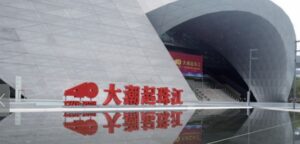 In 2018, in order to celebrate the 40th anniversary of Guangdong’s reform and opening up, the CPC Guangdong Provincial Committee held the “Great Tides Surge along the Pearl River – 40 Years of Reform and Opening Up in Guangdong” in Shenzhen. Since its inception, the exhibition has been based on precise and clear themes and positioning, rooted in Shenzhen, Guangdong, and radiating across the country. It has been created into a “window” with Chinese characteristics, Lingnan style, and modern style, showcasing the achievements of reform and opening up, the spirit of reform and opening up, and the “four confidences”. Out of more than 17000 items collected, borrowed, and collected by the museum, 2403 items were selected for physical exhibition, which not only reflect major events and important figures of reform and opening up, but also reflect the achievements of social and technological development, people’s sense of gain, happiness, and security.
In 2018, in order to celebrate the 40th anniversary of Guangdong’s reform and opening up, the CPC Guangdong Provincial Committee held the “Great Tides Surge along the Pearl River – 40 Years of Reform and Opening Up in Guangdong” in Shenzhen. Since its inception, the exhibition has been based on precise and clear themes and positioning, rooted in Shenzhen, Guangdong, and radiating across the country. It has been created into a “window” with Chinese characteristics, Lingnan style, and modern style, showcasing the achievements of reform and opening up, the spirit of reform and opening up, and the “four confidences”. Out of more than 17000 items collected, borrowed, and collected by the museum, 2403 items were selected for physical exhibition, which not only reflect major events and important figures of reform and opening up, but also reflect the achievements of social and technological development, people’s sense of gain, happiness, and security.
 Nantou Ancient Town is located to the north of Nantou Flyover, Nanshan District, Shenzhen, covering an area of about 70,000 square meters. According to historical records, it was the residence of officials in charge of salt during the Han Dynasty. During the Three Kingdoms period, the official responsible for salt built “Wu Cheng” at its original site. In the 6th year of Xianhe in the Eastern Jin Dynasty (AD 331), the towns of Dongguan County and Bao’an County were built here. In the Ming and Qing dynasties, it was called Xin’an County. As an important transportation hub for rivers and the sea, it has long been a military center for coastal defense. Since the Jin Dynasty, Hong Kong, Macao, Zhuhai, Zhongshan, Dongguan and other places have long been under the jurisdiction of Nantou Ancient Town, which is both the source of Shenzhen’s urban history and the root of Shenzhen-Hong Kong culture.
Nantou Ancient Town is located to the north of Nantou Flyover, Nanshan District, Shenzhen, covering an area of about 70,000 square meters. According to historical records, it was the residence of officials in charge of salt during the Han Dynasty. During the Three Kingdoms period, the official responsible for salt built “Wu Cheng” at its original site. In the 6th year of Xianhe in the Eastern Jin Dynasty (AD 331), the towns of Dongguan County and Bao’an County were built here. In the Ming and Qing dynasties, it was called Xin’an County. As an important transportation hub for rivers and the sea, it has long been a military center for coastal defense. Since the Jin Dynasty, Hong Kong, Macao, Zhuhai, Zhongshan, Dongguan and other places have long been under the jurisdiction of Nantou Ancient Town, which is both the source of Shenzhen’s urban history and the root of Shenzhen-Hong Kong culture.
